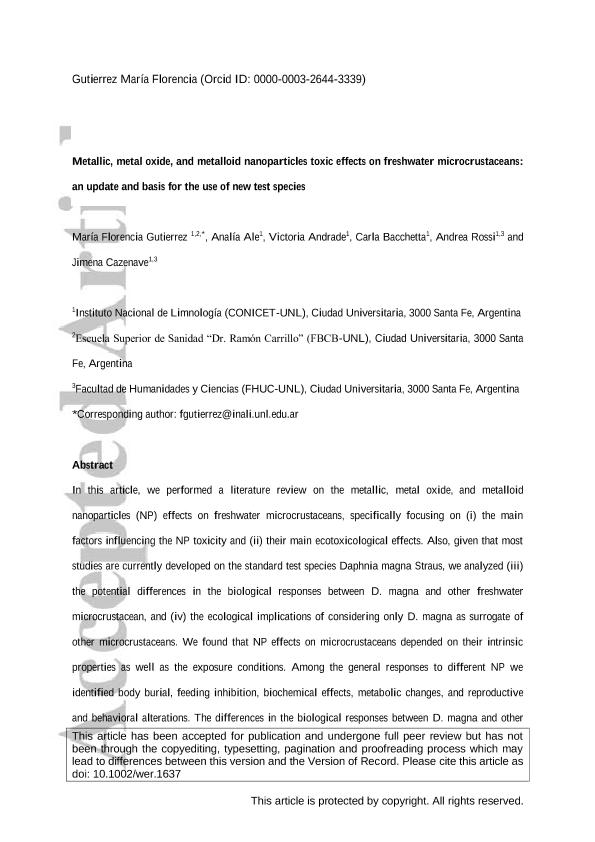Mostrar el registro sencillo del ítem
dc.contributor.author
Gutierrez, María Florencia

dc.contributor.author
Ale, Analía

dc.contributor.author
Andrade, Victoria Soledad

dc.contributor.author
Bacchetta, Carla

dc.contributor.author
Rossi, Andrea Silvana

dc.contributor.author
Cazenave, Jimena

dc.date.available
2023-01-20T20:04:16Z
dc.date.issued
2021-09
dc.identifier.citation
Gutierrez, María Florencia; Ale, Analía; Andrade, Victoria Soledad; Bacchetta, Carla; Rossi, Andrea Silvana; et al.; Metallic, metal oxide, and metalloid nanoparticles toxic effects on freshwater microcrustaceans: An update and basis for the use of new test species; Wiley; Water Environment Research; 93; 11; 9-2021; 2505-2526
dc.identifier.issn
1061-4303
dc.identifier.uri
http://hdl.handle.net/11336/185182
dc.description.abstract
In this article, we performed a literature review on the metallic, metal oxide, and metalloid nanoparticles (NP) effects on freshwater microcrustaceans, specifically focusing on (i) the main factors influencing the NP toxicity and (ii) their main ecotoxicological effects. Also, given that most studies are currently developed on the standard test species Daphnia magna Straus, we analyzed (iii) the potential differences in the biological responses between D. magna and other freshwater microcrustacean, and (iv) the ecological implications of considering only D. magna as surrogate of other microcrustaceans. We found that NP effects on microcrustaceans depended on their intrinsic properties as well as the exposure conditions. Among the general responses to different NP, we identified body burial, feeding inhibition, biochemical effects, metabolic changes, and reproductive and behavioral alterations. The differences in the biological responses between D. magna and other freshwater microcrustacean rely on the morphology (size and shape), ecological traits (feeding mechanisms, life cycles), and intrinsic sensitivities. Thus, we strongly recommend the use of microcrustaceans species with different morphological, physiological, and ecological characteristics in future ecotoxicity tests with NP to provide relevant information with regulation purposes regarding the discharge of NP into aquatic environments. Practitioner points: Nanoparticles effects depend on intrinsic and external factors. Nanoparticles affect the morphology, physiology, and behavior. Effects on Daphnia differ from other microcrustaceans. The use of more diverse test species is suggested.
dc.format
application/pdf
dc.language.iso
eng
dc.publisher
Wiley

dc.rights
info:eu-repo/semantics/openAccess
dc.rights.uri
https://creativecommons.org/licenses/by-nc-sa/2.5/ar/
dc.subject
BIBLIOMETRIC ANALYSIS
dc.subject
DAPHNIA
dc.subject
FUNCTIONAL GROUPS
dc.subject
NANOPARTICLES
dc.subject
TOXICITY
dc.subject.classification
Otros Tópicos Biológicos

dc.subject.classification
Ciencias Biológicas

dc.subject.classification
CIENCIAS NATURALES Y EXACTAS

dc.title
Metallic, metal oxide, and metalloid nanoparticles toxic effects on freshwater microcrustaceans: An update and basis for the use of new test species
dc.type
info:eu-repo/semantics/article
dc.type
info:ar-repo/semantics/artículo
dc.type
info:eu-repo/semantics/publishedVersion
dc.date.updated
2022-05-06T16:20:28Z
dc.journal.volume
93
dc.journal.number
11
dc.journal.pagination
2505-2526
dc.journal.pais
Estados Unidos

dc.journal.ciudad
Nueva Jersey
dc.description.fil
Fil: Gutierrez, María Florencia. Consejo Nacional de Investigaciones Científicas y Técnicas. Centro Científico Tecnológico Conicet - Santa Fe. Instituto Nacional de Limnología. Universidad Nacional del Litoral. Instituto Nacional de Limnología; Argentina
dc.description.fil
Fil: Ale, Analía. Consejo Nacional de Investigaciones Científicas y Técnicas. Centro Científico Tecnológico Conicet - Santa Fe. Instituto Nacional de Limnología. Universidad Nacional del Litoral. Instituto Nacional de Limnología; Argentina
dc.description.fil
Fil: Andrade, Victoria Soledad. Consejo Nacional de Investigaciones Científicas y Técnicas. Centro Científico Tecnológico Conicet - Santa Fe. Instituto Nacional de Limnología. Universidad Nacional del Litoral. Instituto Nacional de Limnología; Argentina
dc.description.fil
Fil: Bacchetta, Carla. Consejo Nacional de Investigaciones Científicas y Técnicas. Centro Científico Tecnológico Conicet - Santa Fe. Instituto Nacional de Limnología. Universidad Nacional del Litoral. Instituto Nacional de Limnología; Argentina
dc.description.fil
Fil: Rossi, Andrea Silvana. Consejo Nacional de Investigaciones Científicas y Técnicas. Centro Científico Tecnológico Conicet - Santa Fe. Instituto Nacional de Limnología. Universidad Nacional del Litoral. Instituto Nacional de Limnología; Argentina. Universidad Nacional del Litoral. Facultad de Humanidades y Ciencias; Argentina
dc.description.fil
Fil: Cazenave, Jimena. Consejo Nacional de Investigaciones Científicas y Técnicas. Centro Científico Tecnológico Conicet - Santa Fe. Instituto Nacional de Limnología. Universidad Nacional del Litoral. Instituto Nacional de Limnología; Argentina. Universidad Nacional del Litoral. Facultad de Humanidades y Ciencias; Argentina
dc.journal.title
Water Environment Research

dc.relation.alternativeid
info:eu-repo/semantics/altIdentifier/url/https://onlinelibrary.wiley.com/doi/10.1002/wer.1637
dc.relation.alternativeid
info:eu-repo/semantics/altIdentifier/doi/http://dx.doi.org/10.1002/wer.1637
Archivos asociados
